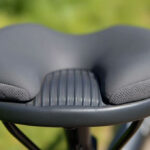Mastering Bike Derailleur Adjustment for Smooth Shifting
How to adjust a bike derailleur is a common question among cyclists, and for good reason. Whether you’re a seasoned rider or just starting out, derailleur problems can be a major headache. To get you rolling smoothly again without sifting through a lot of content, here’s a quick rundown to solve most issues:
- Check chain wear: Use a chain checker tool.
- Inspect housing and cables: Look for bends or fraying.
- Align derailleur hanger: Ensure it’s not bent.
- Adjust limit screws and cable tension: Fine-tune for clean shifts.
Adjusting your bike’s derailleur is crucial for maintaining smooth and safe rides. When your derailleur isn’t set correctly, you may experience clicking, chain skips, or even your chain jumping into the spokes. These issues not only hamper your cycling experience but could also lead to serious damage and accidents.
Common issues causing derailleur problems include chain wear, damaged housing or cables, and a bent derailleur hanger. Ignored, these can escalate from minor annoyances to costly repairs.
Stay tuned as we dig into each aspect with clear steps and tips to help you fine-tune your bike like a pro!

Understanding Your Rear Derailleur
Your rear derailleur is a small but mighty component of your bike. It’s responsible for moving your chain across the cogs of your cassette, ensuring smooth and precise shifting. Let’s break down its parts and functions to help you understand how it works and how to adjust it.
Parts of the Rear Derailleur
A rear derailleur consists of several key parts:
- B-Knuckle: The upper part of the derailleur that connects it to the bike frame.
- B-Tension Adjuster: Fine-tunes the height of the guide pulley.
- Barrel Adjuster: Adjusts the cable tension for precise shifting.
- Guide Pulley: Keeps the chain aligned as it moves from cog to cog.
- Idler Pulley: Maintains chain tension regardless of the gear.
- Mounting Bolt: Attaches the derailleur to the frame.
- Parallelogram Linkage: Allows the derailleur to move left and right, and up and down the cassette.
- High and Low Limit Stops: Prevent the chain from dropping off the smallest or largest cog.
- Cable Bolt: Secures the shift cable in place.
- Cage: Holds the pulleys and keeps the chain in line.
Function of the Rear Derailleur
The rear derailleur works by moving your chain across the cassette’s cogs and maintaining proper chain tension. When you shift to a larger cog, the shifter cable pulls the derailleur forward, pushing the chain onto the larger sprockets. When you shift to a smaller cog, the cable releases the derailleur, allowing it to swing outward and take up the chain slack.
Types of Rear Derailleurs
There are a few different types of rear derailleurs, each with their own unique features:
- Mechanical Derailleurs: These use a cable and spring mechanism for shifting. They’re common on most bikes and require regular adjustment.
- Electronic Derailleurs: These use motors and electronic signals to shift gears. They’re precise and require less maintenance but can be more expensive.
- Rapid Rise Derailleurs: These are a type of Shimano derailleur that shifts in the opposite direction of traditional derailleurs, moving to a lower gear when the cable is released.
Understanding these basics will help you diagnose and fix shifting issues more effectively. In the next section, we’ll cover the preliminary checks you should perform before making any adjustments.
Preliminary Checks Before Adjustment
Before diving into how to adjust a bike derailleur, it’s crucial to perform a few preliminary checks. These steps will help you identify any underlying issues that could be affecting your bike’s shifting performance.
Chain Wear
Chain wear is one of the most common issues that can cause shifting problems. Over time, the rollers and pins in your chain wear down, causing the chain to “stretch.” This can lead to rough shifting, chain skipping, or even the chain falling off unexpectedly.
How to Check Chain Wear:
- Get a Chain Checker Tool: This handy tool will tell you if your chain is worn out.
- Measure the Wear: Place the tool on the chain. If the 0.5% side fits between the rollers, your chain is worn and needs replacing. For 11 and 12-speed chains, most manufacturers recommend replacing the chain at 0.5% wear.

Damaged Housing or Cable
Damaged housing or frayed cable can also cause shifting issues. The housing protects the cable that moves your derailleur, and any damage can restrict its movement.
How to Inspect Housing and Cable:
- Visible Inspection: Look for any bends, pinches, or frays in the housing and cable.
- Check the Rear: Pay special attention to the area where the cable bends at the derailleur and is secured with a bolt.
- Replace if Necessary: If you find any damage, replace the housing and cable.
Bent Derailleur Hanger
A bent derailleur hanger is another common culprit for shifting problems. The hanger is designed to be the weak link, so it bends easily to protect more expensive components in case of a fall or impact.
How to Check for a Bent Derailleur Hanger:
- Visual Inspection: From behind your bike, check if the hanger is parallel with the cogs.
- Use a Hanger Alignment Gauge: This tool will help you determine if the hanger is bent and allow you to attempt to straighten it. If it’s too bent, replace it.

Tools You Might Need
- Chain Checker Tool: To measure chain wear.
- Derailleur Hanger Alignment Gauge: To check and adjust the hanger.
- Cable and Housing: For replacements if damaged.
- Lubricant: To keep moving parts running smoothly.
These preliminary checks will help you identify and fix any underlying issues before you start adjusting the derailleur. In the next section, we’ll dive into the specifics of adjusting the limit screws.
Next, we’ll cover the Limit Screws Adjustment to ensure your derailleur moves smoothly across the cassette.
How to Adjust a Bike Derailleur
Limit Screws Adjustment
The limit screws on your derailleur are crucial for preventing the chain from derailing off the cassette. There are two screws: the high limit (H) screw and the low limit (L) screw.
High Limit Screw (H)
The H-limit screw controls how far the derailleur can move outward, preventing the chain from dropping off the smallest cog.
How to Adjust the H-Limit Screw:
- Shift to the Smallest Cog: Make sure the chain is on the smallest cog.
- Turn the H Screw Clockwise: Tighten the H screw until the derailleur stops moving outward.
- Fine-Tune: Back out the H screw slightly until the derailleur aligns perfectly with the smallest cog without making noise.
Low Limit Screw (L)
The L-limit screw controls how far the derailleur can move inward, preventing the chain from falling into the spokes.
How to Adjust the L-Limit Screw:
- Shift to the Largest Cog: Move the chain to the largest cog.
- Turn the L Screw Clockwise: Tighten the L screw until the derailleur stops moving inward.
- Fine-Tune: Back out the L screw slightly until the derailleur aligns perfectly with the largest cog without excessive noise or slow shifting.
Pro Tip: Always make small adjustments and test the shifting after each turn to find the optimal setting.
B Tension Screw Adjustment
The B tension screw adjusts the distance between the top pulley and the cogs, affecting the derailleur’s body angle.
How to Adjust the B Tension Screw:
- Shift to the Smallest Front Chainring and Largest Rear Cog: This position gives the most accurate adjustment.
- Check the Gap: The gap between the top pulley and the largest cog should be around 5-6 millimeters. Use a hex wrench to measure if needed.
- Adjust the B Screw:
- Tighten (Clockwise) to increase the gap.
- Loosen (Counterclockwise) to decrease the gap.
Note: If your bike shifts well, the B screw is likely within an acceptable range.
Cable Tension Indexing
Proper cable tension ensures smooth shifting across all cogs. The barrel adjuster is your main tool for fine-tuning this.
How to Adjust Cable Tension:
- Shift to the Smallest Cog: Ensure the chain is on the smallest cog.
- Test Shifting: Shift up one gear. If it doesn’t shift smoothly, adjust the barrel adjuster.
- Tighten (Counterclockwise) if the chain doesn’t move up.
- Loosen (Clockwise) if the chain overshoots or skips.
Pro Tip: Make small adjustments (quarter turns) and test the shifting each time.
By following these steps, you can ensure your derailleur is perfectly adjusted for smooth shifting. Next, we’ll dive into a Step-by-Step Guide to Adjusting Your Rear Derailleur to walk you through the entire process.
Step-by-Step Guide to Adjusting Your Rear Derailleur
Step 1: Check Chain Wear
Before adjusting anything, ensure your chain is in good condition. Chain wear, or “stretch,” can cause poor shifting and drivetrain damage.
How to Check Chain Wear:
- Use a Chain Checker Tool: Place the tool on the chain.
- Read the Measurement: If the tool shows 0.5% wear, it’s time to replace the chain for 11 and 12-speed chains. For other chains, replace at 0.75% wear.
Pro Tip: Check your chain once a month to prevent further drivetrain damage.
Step 2: Inspect Housing and Cable
Damaged housing or frayed cables can cause shifting issues.
How to Inspect and Replace:
- Visual Inspection: Check the housing from the shifter to the derailleur for bends or pinches.
- Check for Frayed Cables: Look at the cable where it bends at the derailleur.
- Replace if Necessary: If you find any damage, replace both the housing and cable. For bikes with internal routing, consider replacing them to diagnose hidden issues.
Step 3: Align Derailleur Hanger
A bent derailleur hanger can lead to misalignment and poor shifting.
How to Align:
- Use a Derailleur Hanger Alignment Gauge: This tool helps check and correct alignment.
- Check Parallelism: Ensure the hanger is parallel with the cogs.
- Adjust or Replace: If the hanger is bent, use the gauge to realign it. If it’s too bent, replace it.
Step 4: Adjust Limit Screws
The limit screws prevent the derailleur from moving too far inward or outward.
High Limit Screw (H):
- Shift to Smallest Cog: Ensure the chain is on the smallest cog.
- Adjust the H Screw: Turn clockwise to tighten until the derailleur stops moving outward. Fine-tune by backing out slightly until aligned with the smallest cog without noise.
Low Limit Screw (L):
- Shift to Largest Cog: Move the chain to the largest cog.
- Adjust the L Screw: Turn clockwise to tighten until the derailleur stops moving inward. Fine-tune by backing out slightly until aligned with the largest cog without excessive noise or slow shifting.
Step 5: Set B Tension
The B tension screw adjusts the distance between the top pulley and the cogs, affecting the derailleur’s body angle.
How to Adjust:
- Shift to Smallest Front Chainring and Largest Rear Cog: This position gives the most accurate adjustment.
- Check the Gap: Aim for a 5-6mm gap between the top pulley and the largest cog.
- Adjust the B Screw:
- Tighten (Clockwise) to increase the gap.
- Loosen (Counterclockwise) to decrease the gap.
Step 6: Fine-Tune Cable Tension
Proper cable tension ensures smooth shifting across all cogs.
How to Adjust:
- Shift to Smallest Cog: Ensure the chain is on the smallest cog.
- Test Shifting: Shift up one gear.
- Tighten (Counterclockwise) the barrel adjuster if the chain doesn’t move up.
- Loosen (Clockwise) if the chain overshoots or skips.
Pro Tip: Make small adjustments (quarter turns) and test the shifting each time.
By following these steps, you can ensure your derailleur is perfectly adjusted for smooth shifting. Next, we’ll dive into Troubleshooting Common Shifting Issues to help you address any remaining problems.
Troubleshooting Common Shifting Issues
Even after adjusting your derailleur, you might still face some shifting problems. Here are common issues and how to fix them:
Chain Skipping
Symptoms:
- Chain jumps between gears while pedaling.
- Inconsistent feel when shifting.
Causes and Fixes:
- Worn Chain or Cassette: Use a chain checker tool to measure chain wear. Replace if it shows 0.5% wear for 11 and 12-speed chains.
- Incorrect Cable Tension: Adjust the barrel adjuster. Turn it counterclockwise to increase tension if the chain skips to a smaller cog, and clockwise to reduce tension if it skips to a larger cog.
Chain Falling Off
Symptoms:
- Chain drops off the gears.
- Chain falls between the cassette and wheel or off the front chainring.
Causes and Fixes:
- Misadjusted Limit Screws: Check the high and low limit screws. Ensure they’re set correctly to prevent the derailleur from pushing the chain off.
- Bent Derailleur Hanger: Use a derailleur hanger alignment gauge to check the hanger’s alignment. Realign or replace if bent.
Inconsistent Shifting
Symptoms:
- Shifts are not precise.
- Delayed or hesitant gear changes.
Causes and Fixes:
- Damaged Housing or Cable: Inspect the cable housing for kinks or frays. Replace if damaged.
- Improper Cable Tension: Fine-tune the barrel adjuster. Small adjustments can make a big difference.
Stiff Chain Link
Symptoms:
- Regular jump or sticky point while pedaling.
- Chain doesn’t run smoothly through the derailleur pulleys.
Causes and Fixes:
- Stiff Link: Identify the stiff link by backpedaling and watching the chain pass through the pulleys. Use a chain tool to slightly spread the outer plates of the stiff link. If on the road, gently twist the links to free the sticky link.
Excessive Noise
Symptoms:
- Loud or grinding noise while shifting.
- Noise persists even in a single gear.
Causes and Fixes:
- Misaligned Derailleur: Check the derailleur alignment using a hanger alignment gauge. Adjust if necessary.
- Dirty or Dry Chain: Clean and lubricate the chain. A well-lubed chain runs quieter and shifts better.
By addressing these common issues, you can ensure smoother and more reliable shifting. Next, we’ll cover Frequently Asked Questions about How to Adjust a Bike Derailleur to further assist you in perfecting your bike’s performance.
Frequently Asked Questions about How to Adjust a Bike Derailleur
Which way do you adjust a rear derailleur?
To adjust a rear derailleur, you’ll primarily use the barrel adjuster.
- Clockwise turns decrease cable tension, which helps if the chain is struggling to shift to a smaller cog.
- Counterclockwise turns increase cable tension, useful if the chain is slow to shift to a larger cog.
How do you adjust a slipping derailleur?
A slipping derailleur usually means the cable tension is off. Here’s how to fix it:
- Use the barrel adjuster: Turn it counterclockwise to increase tension if the derailleur struggles to shift up, or clockwise to decrease tension if it skips gears or shifts too easily.
- Check limit screws: Ensure the high and low limit screws are set correctly to prevent the chain from going off the cassette.
- Inspect the cable and housing: Look for any damage or fraying that could affect the shifting performance.
How do I know if my derailleur needs adjustment?
You might need to adjust your derailleur if you notice:
- Chain skipping: This can be a sign of incorrect cable tension or worn components.
- Shifting issues: Delayed or imprecise shifts often indicate a need for adjustment.
- Alignment check: Use a derailleur hanger alignment gauge to ensure the derailleur is parallel with the cogs. Misalignment can cause poor shifting.
By keeping these tips in mind, you can maintain smooth and reliable shifting on your bike.
Conclusion
Adjusting your bike derailleur might seem daunting, but with the right steps, it’s manageable. By following our guide, you can ensure your bike shifts smoothly and reliably, making your rides more enjoyable and safe.
Importance of Regular Maintenance
Regular maintenance is vital for keeping your bike in top condition. It prevents minor issues from becoming major problems and extends the life of your drivetrain. Regularly checking your chain, cables, and derailleur alignment can save you time and money in the long run.
Doot Scoot: Your Partner in Eco-Friendly Urban Mobility
At Doot Scoot, we’re passionate about promoting sustainable urban transport. Whether you’re a seasoned cyclist or new to biking, our guides and reviews aim to help you make informed choices for a greener commute.
Customer Support and Community Building
We’re here to support you with any questions or issues you may have. Our goal is to build a community of eBike enthusiasts who share tips, experiences, and support each other. Join us on social media and become part of the Doot Scoot family.
For more tips, guides, and reviews on all things electric bikes, visit our website. Together, we can make urban transport more sustainable and enjoyable.











